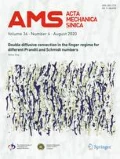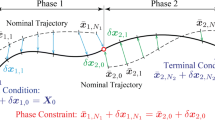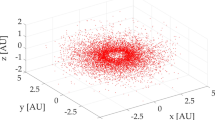Abstract
In the 6th edition of the Chinese Space Trajectory Design Competition held in 2014, a near-Earth asteroid sample-return trajectory design problem was released, in which the motion of the spacecraft is modeled in multi-body dynamics, considering the gravitational forces of the Sun, Earth, and Moon. It is proposed that an electric-propulsion spacecraft initially parking in a circular 200-km-altitude low Earth orbit is expected to rendezvous with an asteroid and carry as much sample as possible back to the Earth in a 10-year time frame. The team from the Technology and Engineering Center for Space Utilization, Chinese Academy of Sciences has reported a solution with an asteroid sample mass of 328 tons, which is ranked first in the competition. In this article, we will present our design and optimization methods, primarily including overall analysis, target selection, escape from and capture by the Earth–Moon system, and optimization of impulsive and low-thrust trajectories that are modeled in multi-body dynamics. The orbital resonance concept and lunar gravity assists are considered key techniques employed for trajectory design. The reported solution, preliminarily revealing the feasibility of returning a hundreds-of-tons asteroid or asteroid sample, envisions future space missions relating to near-Earth asteroid exploration.

















Similar content being viewed by others
References
The global trajectory optimization competition portal, http://sophia.estec.esa.int/gtoc_portal/, cited on December 12 (2014)
Elvis, M.: Let’s mine asteroids for science and profit. Nature 485, 549 (2012)
Brophy, J., Friedman, L., Culick, F., et al.: Asteroid retrieval feasibility study. Keck Institute for Space Studies, California Institute of Technology, Jet Propulsion Laboratory (2012)
García Yárnoz, D., Sanchez, J.P., McInnes, C.R.: Easily retrievable objects among the NEO population. Celest. Mech. Dyn. Astron. 116, 367–388 (2013)
Lladó, N., Ren, Y., Masdemont, J., et al.: Capturing small asteroids into a Sun-Earth Lagrangian point. Acta Astron. 95, 176–188 (2014)
Baoyin, H., Chen, Y., Li, J.: Capturing near Earth objects. Res. Astron. Astrophys. 10, 587–598 (2010)
Hasnain, Z., Lamb, C.A., Ross, S.: Capturing near-Earth asteroids around Earth. Acta Astron. 81, 523–531 (2012)
Urrutxua, H., Scheeres, D., Bombardelli, C., et al.: What does it take to capture an asteroid? A case study on capturing asteroid 2006 RH120, 24th AAS/AIAA Space Flight Mechanics Meeting, Paper 2014–276. San Diego, CA, United states (2014)
Ross, S., Scheeres, D.: Multiple gravity assists, capture, and escape in the restricted three-body problem. SIAM J. Appl. Dyn. Syst. 6, 576–596 (2007)
Schoenmaekers, J., Pulido, J., Cano, L.: SMART-1 Moon mission: trajectory design using the Moon gravity, Technical Report SI-ESC-RP-5501, ESA, European Space Operation Center, Darmstadt, Germany (1999)
Campagnola, S., Russell, R.: The endgame problem part 2: Multi-body technique and T–P graph. J. Guid. Control Dyn. 33, 476–486 (2010)
Cuartielles, J., Alessi, E. M., Garcia Y., et al.: Earth resonant gravity assists for asteroid retrieval missions. International Astronautical Congress, Beijing, China, IAC-13-C1.7.8 (2013)
Alessi, E., Colombo, C., Sanchez, J., et al.: Out-of-plane extension of resonant encounters for escape and capture, International Astronautical Congress, Beijing, Republic of China, IAC-13-C1.9.1 (2013)
Gao, Y.: Near-optimal very low-thrust Earth-orbit transfers and guidance schemes. J. Guid. Control Dyn. 30, 529–539 (2007)
Gao, Y., Kluever, C.: Low-thrust interplanetary orbit transfers using hybrid trajectory optimization method with multiple shooting, Paper 2004–5088, AIAA/AAS Astrodynamics Specialist Conference, August 16–19, 2004, Providence, RI, United states (2004)
Acknowledgments
We would like to express our gratitude to the Chinese Society of Theoretical and Applied Mechanics and the State key Laboratory of Astronautic Dynamics for releasing this interesting problem, which gave us a chance to conduct research on the trajectory design for NEA exploration missions. Meanwhile, this work was also supported by the National Natural Science Foundation of China (Grant 11372311) and the grant from the State key Laboratory of Astronautic Dynamics (2014-ADL-DW0201). In addition, we can provide the data files and verification programs for our submitted solution, and anyone who is interested in this solution can send a request via Email to gaoyang@csu.ac.cn.
Author information
Authors and Affiliations
Corresponding author
Appendix: Ephemerides of the Sun, the Moon, and the asteroid “2003 SM84”
Appendix: Ephemerides of the Sun, the Moon, and the asteroid “2003 SM84”
Rights and permissions
About this article
Cite this article
He, S., Zhu, Z., Peng, C. et al. Optimal design of near-Earth asteroid sample-return trajectories in the Sun–Earth–Moon system. Acta Mech. Sin. 32, 753–770 (2016). https://doi.org/10.1007/s10409-015-0527-1
Received:
Revised:
Accepted:
Published:
Issue Date:
DOI: https://doi.org/10.1007/s10409-015-0527-1




